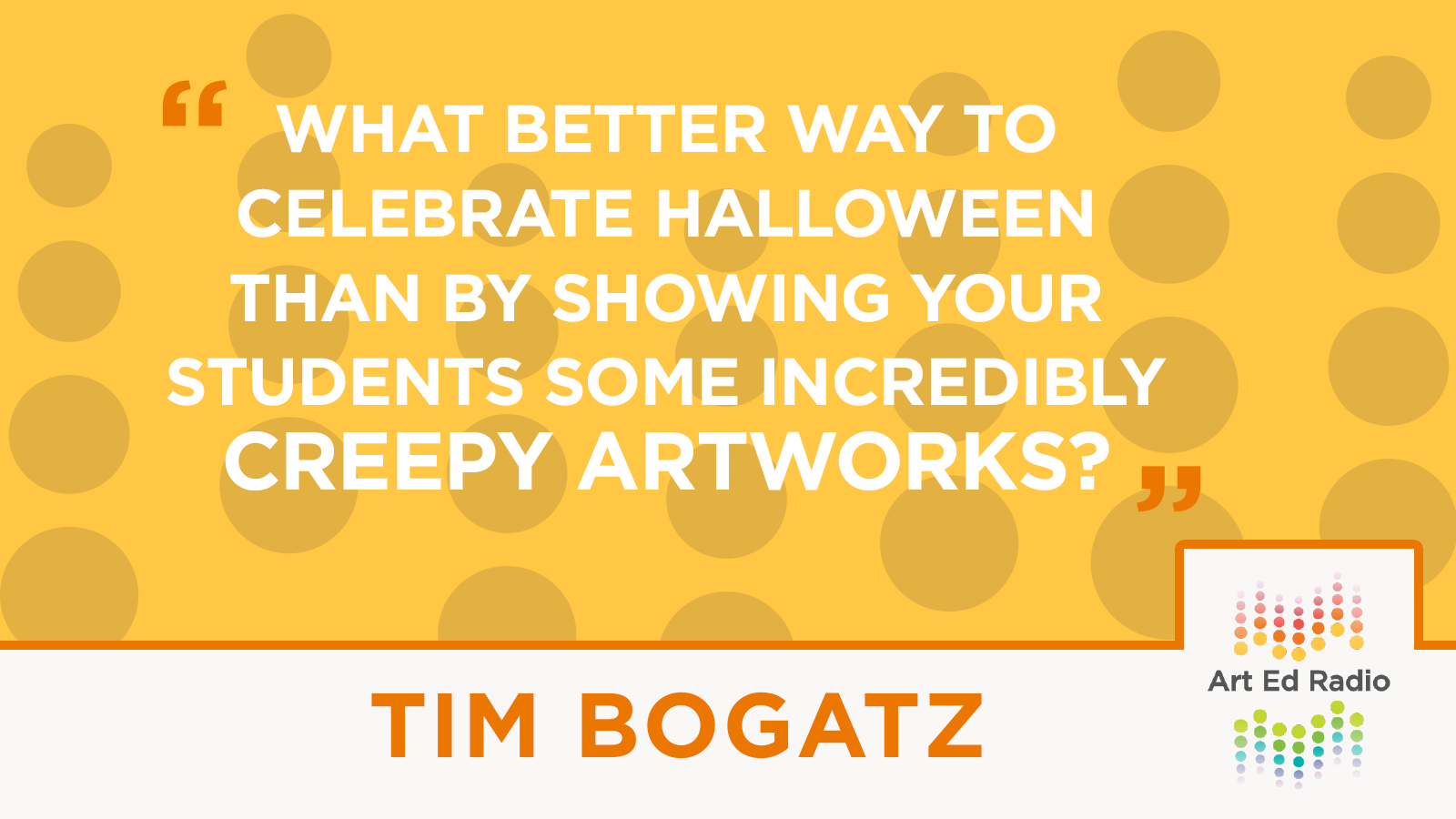It is Halloween week, and Tim’s favorite way to celebrate is by talking about the creepiest artworks he can find from art history! Fellow art history nerd Jenn Russell comes on as they discuss some of the best paintings to show your students for Halloween.
- Head of a Skeleton with a Burning Cigarette, van Gogh
- The Anatomy Lesson of Dr. Nicolaes Tulp, Rembrandt
- The Face of War, Salvador Dali
- Saturn Devouring his Son, Goya
- Judith Cutting of the Head of Holofernes, Artemesia Gentileschi
- Two Fridas, Frida Kahlo
Full Episode Transcript Below.
Resources and Links
- Making Art History Meaningful
- Helping Students Care About Art History
- 3 Amazing Women from Art History

Transcript
Tim: Welcome to Art Ed Radio, the podcast for art teachers. This show is produced by the Art of Education University, and I’m your host, Tim Bogatz. As you know, it is Halloween week, just a couple of days away, and as we always do, it is time for a Halloween-themed podcast. Jen Russell is here to talk with me about our favorite creepy artworks from famous artists, and we will talk about how we present them in our classroom, and how we discuss them with our students. But first, I want to talk to you really briefly about the Art of Education University. If you need to just take one graduate course, if you want to earn a Master’s degree or anywhere in between, make sure you check out courses from the Art of Education University. We offer over 20 online courses, including eight hands-on studio courses. They are designed to help art teachers at every stage of their professional career.
So, whether you’re looking to develop a new art curriculum, get help with fundamentals in your classroom, incorporate new technology or just brush up on your own art-making skills, we have the course for you. You can see what’s available, what interests you and what you may want to sign up for at theartofeducation.edu/courses. Okay, let me bring on Jenn, and we will talk some creepy artworks.
All right. Jenn Russell is joining me now. Jenn, welcome back to the show. How are you?
Jenn: Hi. Good. I’m so excited to be back.
Tim: Good. I am excited to have you back and excited to talk about all of our creepy artworks that we’ve picked out. But first, let’s talk Halloween. Is this a holiday that’s exciting for you? Do you go all out, or is it just kind of a run-of-the-mill sort of thing for you?
Jenn: Oh, no. I go all out as much as I can. In my classroom, I’ve put little … I tend to schedule assignments around … We go through anatomy at this time, so I can have skulls out and I can have window gel clings. I mean, my house is creepy and weird. I mean, our neighborhood goes all out, so everybody goes all out. I love, love, love Halloween.
Tim: That’s awesome. I love it. I have two kids. One is sixth grade, one is fourth grade. My daughter who is in sixth grade is very sad because this is her last trick or treating year. I told her once she gets to middle school, she doesn’t get to go trick or …
Jenn: What? Who said?
Tim: That’s me. That’s me being a mean dad.
Jenn: Love it.
Tim: But she’s going all out. She’s been reading Hunger Games, and so she’s going as Katniss and has made her own costume. She’s very excited. And then, my son who is in fourth grade is just kind of weird, and he’s going as an ear of corn, so he’s pretty excited about that.
Jenn: I am obsessed with that thought. This will be my son’s first cognizant Halloween. He was three months old last year. Had no idea what was happening. But they Trunk or Treat at their preschool, and this is the first time ever that I’ve ever Trunk or Treated, and I think I’m being a little excessive with it. It’s a contest, and I’m here to win. I feel like I have a little bit of an advantage being an art teacher. It’s Harry Potter-themed.
Tim: Oh, I love it already.
Jenn: Yeah. So, I mean, I have the four houses, the flying car, we’ve got wands, we’ve got Dementors, we’ve got the Quidditch towers that are framing our trunk. My kids are like, “Okay, really Russ? Do you think this is a bit much?” I was like, “Yeah, probably. But I don’t really know any … ”
Tim: It is, but it’s also amazing.
Jenn: Yeah. I don’t really know any other way to live except for being excessive.
Tim: That’s good. I’ve only done Trunk or Treat once, but I have a black car, and then I got just all sort of, I don’t know, huge piping and turned it into a giant spider with these giant legs coming out all over.
Jenn: That’s awesome.
Tim: So, we ended up taking up three parking spots, which people weren’t happy with because the legs were so gigantic, but it looked really, really cool.
Jenn: No, that’s really what it’s about. As art people, I just feel like we have an obligation to just be extra.
Tim: Exactly. Cool. All right, so let’s talk artwork. We put together a big list of artworks that are super creepy, super fun to share at this time of the year. We’ll just kind of go through them, talk about what we love and I guess how we talk about our kids with them. Talk about them with our kids, yeah, that’s what I’m trying to say.
All right, so number one on our list is van Gogh’s Head of a Skeleton with a Burning Cigarette. I love this one. For those of you that don’t know it, it’s just that solid black background, a skull very loosely painted because it’s van Gogh, and it’s just smoking a cigarette. I don’t know. I get the greatest reaction from my kids with this. They think it’s so cool but so funny at the same time for whatever reason. What do your kids say when they see this?
Jenn: So, like I said, I schedule anatomy around this time, and I feel bad for my spring drawing classes that don’t get anatomy around a spooky time, but that’s awesome. I do point this out, and I talk a lot about … They just think it’s the epitome of cool, and then I tend to bring in advertising in the 50s and 60s and how that was what they were trying to go for, especially with cigarette smoking, was just that it was cool. But they really do think that this is just super cool, and this is one of the few times that I feel a solid black background just absolutely works in a piece that doesn’t have anything going on. I mean, it doesn’t even have differentiation of color. It’s just black. It’s just pure black. And then, I teach high school, so I get some kiddos that are like, “Black like my soul.”
Tim: Oh, god.
Jenn: Yeah. Sure. But they love it. One of my kids was like, “It’s very James Dean-esque.” I was like, “Oh, my gosh. You’re so right.” So, they can see people … It’s almost like an x-ray of someone they know minus the cigarette probably. They’re like, “How can we turn this into something modern.” I’m just like, “Let’s not go there.” But yeah, they absolutely love it, and then they talk about just the structure and just the variance of color or just value that makes the biggest of difference here because it’s very limited color options, but the value-
Tim: Yeah. That’s one of the things that my kids always pick up on. They’re like, “Seriously, this is van Gogh?” Because we’re used to flowers and these beautiful scenes and all of these fields with blues and greens and just these beautiful colors. Then all of a sudden, there’s just death personified. It’s really shocking to them that van Gogh painted this, so that’s always a good road that we go down too.
Now, speaking of anatomy, we need to go down a little further on our list. Rembrandt’s painting, The Anatomy Lesson of Dr. Nicolaes Tulp, which not everybody knows the title, but I think everybody knows the painting where it’s one guy in traditional, Dutch, Flemish garb with the cadaver laid out. He’s cutting into the arm, and you can see all of the veins and the bones inside of the arm. There’s about a half dozen guys just sort of staring in there. It’s kind of weird at first when you first see it. You’re like, “Okay, what’s going on here?” And then you look closer, and the cadaver’s face is all sunken in, looks really gross. And then, the arm is completely cut open. Kids are really quiet when they see this for the first 30 seconds or so, and then they start to see what’s going on, and they’re like, “Oh, gross.” Do you have the same reaction from your kids?
Jenn: Yeah. I don’t know if your kiddos are like this, but my kids think that they’re surgeons because they have been to watch however many seasons of Grey’s Anatomy that are on Netflix, and so they’re like, “They can’t even do that. They can’t take the bones out and the nerves. How is it that … No, they have to peel back the skin, and you need a plastic surgeon for that.” I’m like, “Y’all, can we please pay attention to the fact that this is a … First of all, look at the realism here. He’s teaching, obviously, a surgical procedure in the 1600s, so what is that? Are we not concerned?” But they’re very concerned about just the actual surgical part. And then, they start to realize that none of the guys are actually looking at the arm. There’s one that’s looking at the arm. But everybody else is just looking in random places.
So, they’re like, “Wait, what are they looking at? Also, homeboy is really short. What’s that about?” I’m like, “Thank you, guys. Thank you for pointing out all the things that we need to talk about.”
Tim: Yeah, and they’re all dressed the same. All of the guys have the same facial hair. It’s a weird painting. There’s a lot to dive into on that one.
Jenn: Yeah. I was like, “Are they looking at the book? But why isn’t the book closer?” We unpack a lot, but yeah, they’re mostly concerned about the proportions in that they’re slightly off of the cadaver. They’re like, “Is it for shortening because he’s at an angle, so it’s weird. We feel like he should be longer or his legs should be longer and his torso should be shorter, and the arm is weird.” I’m like, “It’s all just weird.”
Tim: It is. It’s all very weird. I don’t know. I always just tell my kids that Rembrandt was way more worried about light and shadow, so he didn’t bother nearly as much with getting proportions right. Who knows? But I’ll trust Rembrandt more than … Yeah, he knows what he’s doing.
Jenn: Right. More than my class full of surgeons.
Tim: Yes. Your wannabe surgeons, yeah. All right. Next on the list, we would not be complete talking about creepy artworks if we did not talk about Salvador Dali. There’s obviously a lot of options here that you can go for if you’re talking Dali. But I think one of his creepiest is the one called Face of War, which landscape background because it’s Dali, but then the giant head right in the middle. It’s got two way-too-big eyes and a big open mouth. Inside of those eyes are another creepy face, and inside of the eyes of that creepy face are another creepy face, and on and on. So, yeah, it’s sort of weird, sort of disturbing. The hair on the face also looks like snakes, and it’s kind of weird one. It’s another one where there’s a lot to look at.
Jenn: Yes. A very popular thing to do when they’re drawing skulls or faces or eyes that they always want to put stuff in that.
Tim: Yes.
Jenn: And it’s their go-to for when it’s like, “Oh, I’m in my feelings. I’m going to put whatever I’m going through in my eyes.” I’m just like, “Okay, guys, let’s dig a little deeper.” But we talk about this in just the usage of the landscape, the horizon, and then you have this, again, beautiful landscape, but you can’t really appreciate it because there’s this thing blocking your view of all of this hard work. And then, you’re so engrossed in what’s happening. I use this as an example of something that draws your viewer in. Sometimes you want your viewer to look at your piece from afar, and sometimes you want them closer. So, I use this as an example of a time when you want them closer so that your craftsmanship and your finishing has to be so on-point because you know that someone is going to literally walk up to your piece and breathe on it because they’re going to want to figure out how many layers of that do we have going on.
Mostly they’re just creeped out by it because they don’t know what’s going on or what is the purpose of it. Then they’re like, “These weird curls. Wait, no, they’re snakes. It’s weird. No.” Yeah, they talk a lot about that, about how many times he had to draw these little faces over and over again. And what possesses you to put them there?
Tim: Yeah. It’s a weird … I mean, it’s Dali, so obviously it’s weird. But just sort of that … Kids are fascinated by that infinity concept where it just gets smaller and smaller inside of there. It’s fun to think about. Next on the list, maybe for my money the creepiest artwork of all time, is Saturn Devouring His Son by Goya. Man, I think everybody knows this one. Very black in the background, and then a giant, I don’t know, just creepily painted dude with gross hair and a manic face, and he’s eating another human. Or I guess they’re gods technically because he’s Saturn. But anyway, we’re missing a head, we’re missing an arm. The mouth is open, and we’re about to be missing another arm. There’s blood all over. It’s disgusting and bothersome and creepy. But, for whatever reason, kids love it.
Jenn: Yes. This is one that I just have typically in … I present with a group of images, and they pick this one out, and they’re like … And that’s all I get.
Tim: It is. It’s so weird and so creepy. Kids just don’t know how to react to it because it’s bothersome, especially when you’re seeing it for the first time.
Jenn: But it’s a good one when they start to look at … Someone, inevitably, every year wants to do something with mythology for their portfolio or for a piece or whatever, so we bring this up and they’re just like, “Okay.” So, this forces them to go look up the entire story and they’re like, “Wait, does that have anything to do with the story? I don’t remember what the story is, but then also I don’t know who Saturn is. Is this Greek or is the Roman?” Then they dive into this research. I really like this as a conversation starter, but typically it just takes them a minute because they’re like, “I don’t know. I don’t know what’s going on.” Then they look at just proportions of Saturn and proportions of the son and they’re just like, “His son is hippy.” I’m just like, “Okay, guys.” So, then they start to dive a little deeper into what’s actually happening, but this is one of the few pieces that, again, doesn’t need a lot to invoke all of these unnerving feelings.
Tim: Yeah, for sure.
Jenn: So, they have a good example of that.
Tim: Yeah. When I’m showing it, I like to do kind of a narrative of Goya’s life. We can start with all of those beautiful, not religious, but royal court paintings that he did of kings and queens and nobles and whatever you want to call them. Then, later in life, he just started withdrawing from everyone. He moved up to this hill in the cliffs, and then painted his entire house with these dark, disturbing images. We just talk about this was literally in his bedroom. This painting was in his bedroom. Can you imagine going to sleep every night? So, we actually usually get into a good discussion on mental health and everything that goes along with that. So, yeah it’s fascinating to kind of look at his life and everything that he’s putting together and how he lived his life and the progression into this dark sort of place and all of the work that went along with that. That always makes for a good discussion.
Jenn: Yes.
Tim: Now, next one. I need to ask if you even show this one because it’s pretty brutal, it’s pretty violent. Artemisia Gentileschi’s painting of Judith Cutting off the Head of Holofernes where it’s got Judith, she’s got the sword, she’s got her handmaid working with her, and they’re literally slicing off this guy’s head. Is this one that you show in your classroom?
Jenn: Yes. And also too, we have a separate art history class, and I know that they go through a lot. I’m just like, “If it can be part of an art history textbook, then it should be able to be shown in class.” But I always preface it with, “Fair warning, guys.” Same thing when you show David, or when you show any sculpture or anything that … Especially getting into anatomy and figure drawing and what figure drawing traditionally is. A lot of my kids go to art school and I’m like, “Hey you guys, just so you know, when you get into figure drawing or when we go visit museums, don’t snicker, don’t giggle because this is how we get to not go places.”
Yeah, so I always have to preface it by, “Hey, just so you know, this is a little much, but this is such an important piece and especially done by woman.” So, we talk about just … And my girls always go insane for it. They’re like, “Yes, queen. You do that.” The boys are always like, “Okay, wait a minute. Hold on here. What is happening?” Everybody just comes to a consensus on just her facial expression. How Judith is just, “Hey, this is just another day. I need to handle this business, and if you could just hold still for me, this will go a lot quicker.”
They just have this entire narrative that they build up, which is great because it just starts an entire conversation about how they’re just taking charge or what happened to get to this point. I just love the story that they attach to it. They seem to overlook the bit of the gore because they love it. They absolutely love the fact that she’s just going to town, and she’s like … This is kind of gross, but you got to go buddy.
Tim: Yeah.
Jenn: So, they love it. Obviously, my girls love it a little bit more. They see it as a female empowerment piece. I’m like, “That’s not cool, chopping heads.”
Tim: It definitely is. I always show Caravaggio’s painting of the same subject. He did a Judith cutting off the head of Holofernes, same story. But Gentileschi’s painting is just so much better in every way. So, my kids are like, “Wait, so the women painted better than the men?” I’m like, “Well, yes, but … ” So, we just talk about different time periods, different understandings, different techniques and all the things that go into that. But that’s their big takeaway. Like you said, I love doing the storytelling aspect of it where I have the kids come up with what they think is happening, and then I will tell them the actual story. Holofernes is going to absolutely massacre all of Judith’s people, and so here’s what she did, and just tell them the whole story going along with that.
It’s kind of fun because a lot of times they can come close to what the story actually is, so that’s a fun one to … I don’t know if I should describe it as fun because there’s nothing fun about the painting, but it always makes for really interesting discussions. That’s what we’re going for.
All right, so just one last painting here that I want to talk about because you and I always go way too deep on all of these paintings and talk too long. Frida Kahlo, she’s got a lot. She’s like Dali where there’s a lot of just weird, wild, fascinating stuff that we could do, but I love the Two Fridas painting where they’re sitting side by side. Beautiful background with the sky, the clouds, and then the two hearts beating, the veins going back and forth. The figure on the right is dressed blue, green, fairly traditional. And then, the figure on the left is dressed all in white, the second Frida. She has the scissors, she has the vein cut, the blood dripping all over that white dress. It’s another one that kind of lends itself to a lot of great storytelling and having the kids try and figure out what is Frida trying to tell us with this painting. What do those discussions look like in your classroom with this one?
Jenn: Yeah, this is one of … Typically, I use Frida as essay pieces when they have to do a longer write. We do a lot of quick writes in class, but when they have to do a longer essay … Specifically this one, we got a chance to see it. It came to the DMA here in Dallas. We all dressed up as Frida Kahlos because we were trying to break a world record. I don’t think we got there, but we got to be all Fridas, boys included, which is great inclusion. They got to see it up close. First of all the piece is huge, but this talks a lot about just her inability to reconcile the Mexican side and the German side of herself. They first talk about what they feel the piece could be about, and then once they hear the story, it’s so relatable to them because everybody has multiple things that they’re trying to mend together with themselves. So, they really, really go for it.
But they’re definitely unnerved by the blood. They’re just like, “Why is the heart broken? Why is the vein … ?” Again, Grey’s Anatomy, thank you. They’re like, “She has it clamped, but it’s still bleeding. That is not okay.” I’m like, “How do y’all know that these are clamps?” They talk a lot about how sometimes you try and you try to fix something, and even the thing that’s supposed to fix it, doesn’t fix it. I remember reading that on several essays. I was like, “Oh, my gosh. You guys, this is good.” So, this is definitely one of the pieces that gives them liberty to go a little further because she’s so recognizable, but also because there’s two versions of everybody.
Jenn: Whether you mean for it to be like that or not, you’re different with different groups of friends. You’re different with your parents. So, it’s so relatable to them that they can really dive deep, but they’re very unnerved with the heart specifically. And then the stormy sky, it doesn’t bode well for them either. They’re just like, “I don’t know. It just makes me a little nervous.”
Tim: It does, but good work makes you feel though. That’s what I always tell my kids, and that’s what I tell my own kids at home. Good stories and good works of art, they make you feel all of the emotions. This is one that most definitely does that. It’s always good to talk about and to look at. All right. Jenn, thank you. This has been a super fun discussion. I really appreciate you coming on, and hopefully we can talk to you again soon.
Jenn: Of course. Thank you so much.
Tim: All right. Now, we actually had a couple more artworks on the list, but since Jen and I always seem to nerd out about art history, we went a little long on all of our discussions. I hope that what we said can maybe give you some ideas for works you may want to use in your classroom and some ideas on how to present them. The list one more time for those of you who are taking notes at home, van Gogh’s Head of a Skeleton with a Burning Cigarette, Rembrandt’s Anatomy Lesson of Dr. Nicolaes Tulp, Salvador Dali’s The Face of War, Goya’s Saturn Devouring His Son, Artemisia Gentileschi’s Judith Cutting Off the Head of Holofernes, and Frida Kahlo’s Two Fridas. The two that did not make the cut today are Caravaggio’s Medusa. Look that up, and you’ll see just a decapitated Medusa head with this crazed look in her eyes and all of these snakes for hair that just fit right in with everything else we were talking about today.
And also, Francis Bacon’s Study After Velazquez’s Portrait of Pope Innocent X. Just look that up. It’s a little disturbing, especially the first time you see that. My kids are always into that one as well. Anyway, like I said, feel free to look those up if you’re looking for a couple more artworks to show this week because, as we all know, nothing celebrates Halloween better than some of the most creepy examples you can find from art history.
Art Ed Radio is produced by the Art of Education University with audio engineering from Michael Crocker. We’ve been getting a lot of questions lately about the Master’s degree and AOEU, so next week those questions will kind of guide our podcast discussion. We’ll talk to you then.
Magazine articles and podcasts are opinions of professional education contributors and do not necessarily represent the position of the Art of Education University (AOEU) or its academic offerings. Contributors use terms in the way they are most often talked about in the scope of their educational experiences.



